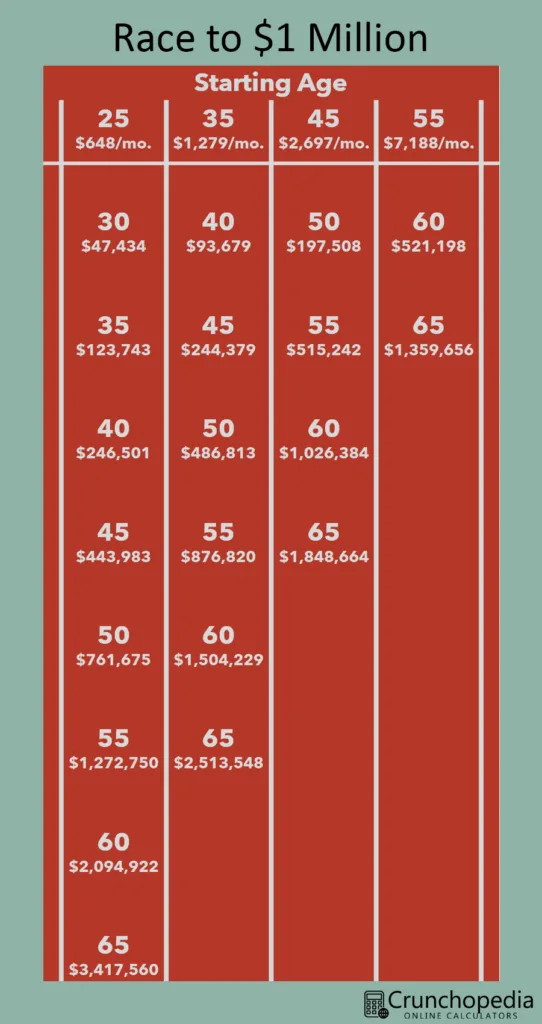Finance Myth #1 Start Saving at Age 40
We can use simple math to demonstrate why waiting to save for retirement is a bad idea. I’m older now, but just like you I was young once too. One of the best decisions I ever made was to start saving for retirement once I had a full time job. If you haven’t started saving for retirement yet, hopefully I’ll convince you to start saving tomorrow.
Social Security in the United States
The Social Security program in the United State was signed into law in 1935, shortly after the end of Great Depression. As of 2019, Social Security provided over $1 trillion in benefits to over sixty-four million Americans. Now a trillion dollars might sound like a lot of money, but when we divide it among sixty-four million families, it works out to $15,365 per recipient annually. Most of us would agree that is not a lot of money.
Unfortunately, there is more unwelcome news. In 2021, for the first time in over 35 years, the assets held by the Social Security program declined. More money was paid out than received via payroll deductions. When I first started working, all the “old timers” told me I’d never collect Social Security. They were wrong. Will the system go bankrupt some day? I doubt it. Would I rely on Social Security as my sole source of retirement income? I started saving at age 22 and 40 years later I have no regrets.
Pay Me Now or Pay Me Later
So, what’s the big deal about saving when you’re just starting out? After all, even when you’re forty you still have twenty years to put money away. Truth be told, you can start at any age. In fact, if you’re willing to roll the dice and count on Social Security, you never need to start. The only thing you’ll give up is living comfortably in retirement or working through retirement.
Saving for retirement isn’t easy, in fact it’s painful because you could be using that money today instead of investing it in tomorrow. In fact, a relative of mine decided they would rather live for the day and not put money away in their employer’s plan. Now this person is 60 years old and is freaking out because they cannot afford to retire. The lesson here? Retirement saving is a pay me now or pay me later situation. Let’s crunch through some numbers to prove this point.
Retirement Planning 101
I’ve done the math to save you some time. For this exercise, I chose four timeframes to start a retirement plan: ages 25, 35, 45, and 55. In each case, I keep the assumptions the same. At the end of the planning period, each person has $1 million in purchasing power today (real dollars). I’ll adjust the retirement target for each person by the average annual rate of inflation (1928 through 2021) of 3.12%. Finally, I will assume the money is invested in the S&P 500, which has an average rate of return (1928 through 2021) of 9.98%. The image below shows the results of this study.

This graphic is interpreted in the following manner. We have each of the four starting ages (25 through 55), and immediately below the age is the amount of money needed to save each month to reach the target of $1 million in purchasing power today at age 65. For example, a 25-year-old needs to save $648 per month for the next 40 years to have $3,417,560 in retirement funds at age 65. The 55-year-old needs to save $7,188 per month for the next ten years to have $1,359,656 in retirement funds at age 65.
I’m also showing how much money each person could have in five-year increments in this race to one million dollars. For example, by age 40, the 25-year-old will have nearly $250,000 given the return-on-investment assumption mentioned earlier.
Eye Opening Results
I knew about the power of compounding (which is the ability of reinvested earnings to generate more earnings), but I was surprised at the cost of a ten-year delay. While the 25-year-old needs to invest $648 per month for forty years to reach their target of $3,417,560, a 35-year-old needs to invest nearly twice that amount ($1,279 per month) for thirty years to hit their target of $2,513,548. We see a similar pattern at age 45, which requires $2,697 per month for twenty years to hit their target of $1,848,664.
Admittedly, not every 25-year-old can afford to save $650 per month. That’s not the point of this analysis. In fact, a 25-year-old making $45,000 per year and putting 12% of their salary away until retirement will have $3,267,842 at age 65 – assuming they get a raise in pay equal to inflation. This is very close to their target value. The point of this analysis is saving for retirement gets more painful the longer you delay starting. It’s not that someone should put exactly this amount each month into their plan. There are too many variable to prescribe an exact amount to save.
Why Pick a One Million Dollar Target?
As a reminder, every age group is targeting the purchasing power of one million dollars today (real dollars), which is the only way to make a fair comparison. If you’re familiar with the rule of 4%, then you know that one million dollars should be able to provide $40,000 in annual income with a high probability of success throughout retirement. Since the calculus used in this analysis is linear, just multiply these values by 1.5 to generate estimates for $60,000 in annual income and so on.

